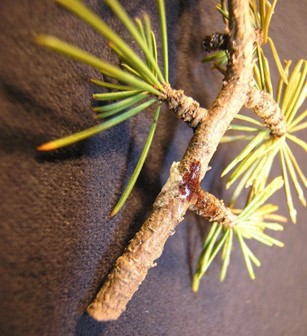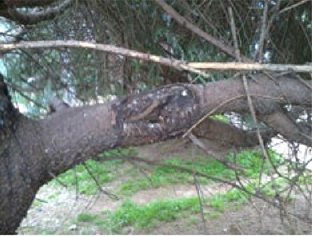Canker Blue Spruce
Contact
Plant Diagnostician
Phone: (479) 575-2727
Email: ssmith@uada.edu
Jason Pavel
Diagnostician
Phone: (479) 575-7257
Email: jpavel@uada.edu
University of Arkansas
Division of Agriculture
Cralley Warren Building
Room 16
2601 N. Young Ave.
Fayetteville, AR 72704
Spruce Cytospora Canker
Sherrie Smith and Jason Pavel
September 19, 2022
Plant Health Clinic Disease Note: Issue 30
Blue Spruce

Spruce Cytospora Canker-Valsa (Cytospora) kunzei
Photo by Sherrie Smith, University of Arkansas Cooperative Extension
Cytospora Canker, caused by the fungus Valsa (Cytospora) kunzei, is a disease of both Colorado and Norway spruce. The disease is found mostly on stressed trees that have been planted outside their normal range. Heat and drought stress, and injury predispose spruce to infection by Cytospora.
Trees do not usually begin to show symptoms until they are ten to fifteen years old. The first symptoms of Cytospora canker are the browning of needles and dying of the lower branches of affected trees. As the disease advances, it spreads to higher branches. Sometimes branches high in the tree are attacked even though lower ones are healthy. The cankers may be discolored, sunken or swollen. They often exude sap which is a bluish-white when dry.
Over time, affected trees become ugly and lose their value for ornamental purposes. The progression of Cytospora canker can be slowed by supplying additional water during dry weather and pruning infected branches.
Pruning should be done when the tree is dormant. Disinfect pruners or limb loppers with 70% rubbing alcohol, or a 10% bleach solution, (nine cups water to one cup bleach), between cuts to reduce the chance of controls for Cytospora canker.
Take Aways:
-
- Provide adequate water during dry periods.
- Fertilize per soil
- Prune out all cankered
This work is supported by the Crop Protection and Pest Management Program [grant no. 2017-70006- 27279/project accession no. 1013890] from the USDA National Institute of Food and Agriculture.

Photo by Michelle Buchannan, formerly, University of Arkansas Cooperative Extension